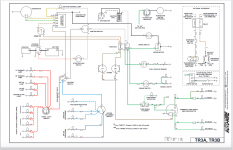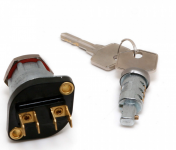OP
SteveBones
Jedi Trainee
Offline
I own a 1958 TR3A. I replaced the original wiring harness and I am now experiencing an issue/problem. In addition I replaced the ignition switch purchased from Moss with the four tab connectors. The other item replaced is the light switch.
My problem or issue occurs when I turn on the ignition switch. The ammeter reading goes to the far end or "pegs" at the maximum reading for negative amps (-30AMPs). I am still able to turn over the starter when I push the starter button. The starter is a reduction gear starter and turns over as expected. Any suggestions on how to figure out what is causing this very high reading on my ammeter is greatly appreciated. Please note the lights work including dash, parking, and head lights. Horn works as well. My TR3A is set up for positive ground. Attached is a copy of the wiring diagram I am using.
Thanks,
Steve
My problem or issue occurs when I turn on the ignition switch. The ammeter reading goes to the far end or "pegs" at the maximum reading for negative amps (-30AMPs). I am still able to turn over the starter when I push the starter button. The starter is a reduction gear starter and turns over as expected. Any suggestions on how to figure out what is causing this very high reading on my ammeter is greatly appreciated. Please note the lights work including dash, parking, and head lights. Horn works as well. My TR3A is set up for positive ground. Attached is a copy of the wiring diagram I am using.
Thanks,
Steve

 Hey there Guest!
Hey there Guest!
 smilie in place of the real @
smilie in place of the real @
 Pretty Please - add it to our Events forum(s) and add to the calendar! >>
Pretty Please - add it to our Events forum(s) and add to the calendar! >> 





 A friendly reminder - be careful what links you click on here. If a link is posted by someone you don't know, or the URL looks fishy, DON'T CLICK. Spammers sometimes post links that lead to sites that can infect your computer, so be mindful what you click.
A friendly reminder - be careful what links you click on here. If a link is posted by someone you don't know, or the URL looks fishy, DON'T CLICK. Spammers sometimes post links that lead to sites that can infect your computer, so be mindful what you click.